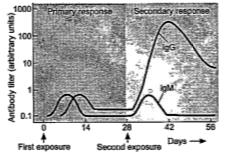The entry of an antigen is sensed by the B-cells. The B-cells become active and synthesize specific protein molecule called the antibody, which is secreted into the plasma. Upon encountering the antigen, the antibodies bind with the antigen molecules and deactivate them. This whole process takes from days to weeks during first exposure but will be rapid upon second exposure due to the memory which was built up during first encounter with the pathogen. This phenomenon of recognizing an antigen is called as immunization and this lead to the basis of vaccination. 0.16 Vaccination is the process by which an individual's immune system is strengthened against a particular First exposure infectious agent.

Vaccines set off immune response to pathogens by producing and storing:
Video Solution
Text Solution
Antibodies: Vaccines reduce risks of getting a disease by triggering the natural defense system of body. It produces antibodies which fight immediately against pathogen and keeps the memory for future defense as well.
|
Similar Questions
Knowledge Check
Antibodies combine with antigens
AOnly if macrophages are presentBat constant regionnCat variable regionDBoth (a) and (c)Binding of antigen to antibody is through
AElectrostatic interactionsBCovalent bondsCDisulphide bridgesDAmide formationBinding of antigen to antibody is through
AElectrostatic interactionsBCovalent bondsCIssacs and LindermannDRandles
Immune response to first encounter with an antigen is called (
View SolutionAntigen sites recognised by antibodies and T-or B-cells are
View SolutionThe region of antibody that recognises the antigen is called :-
View SolutionImmune response to first encounter with an antigen is called:
View SolutionStudy of antigen and antibodies found in blood -
View Solution
